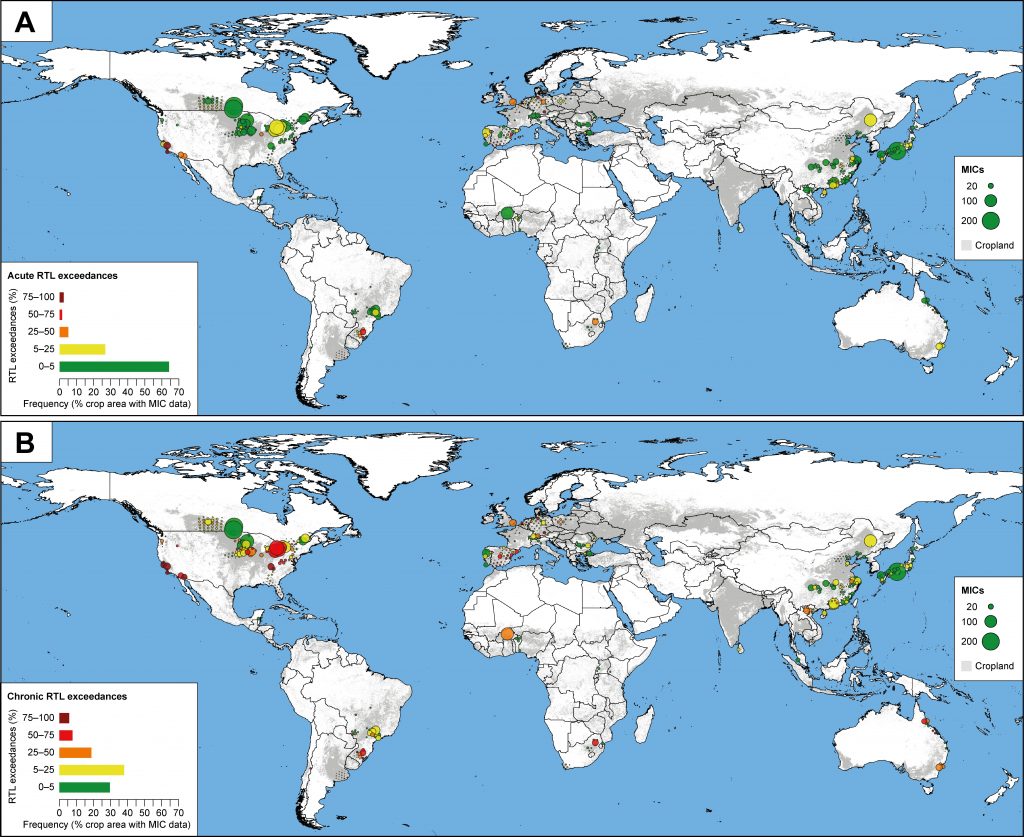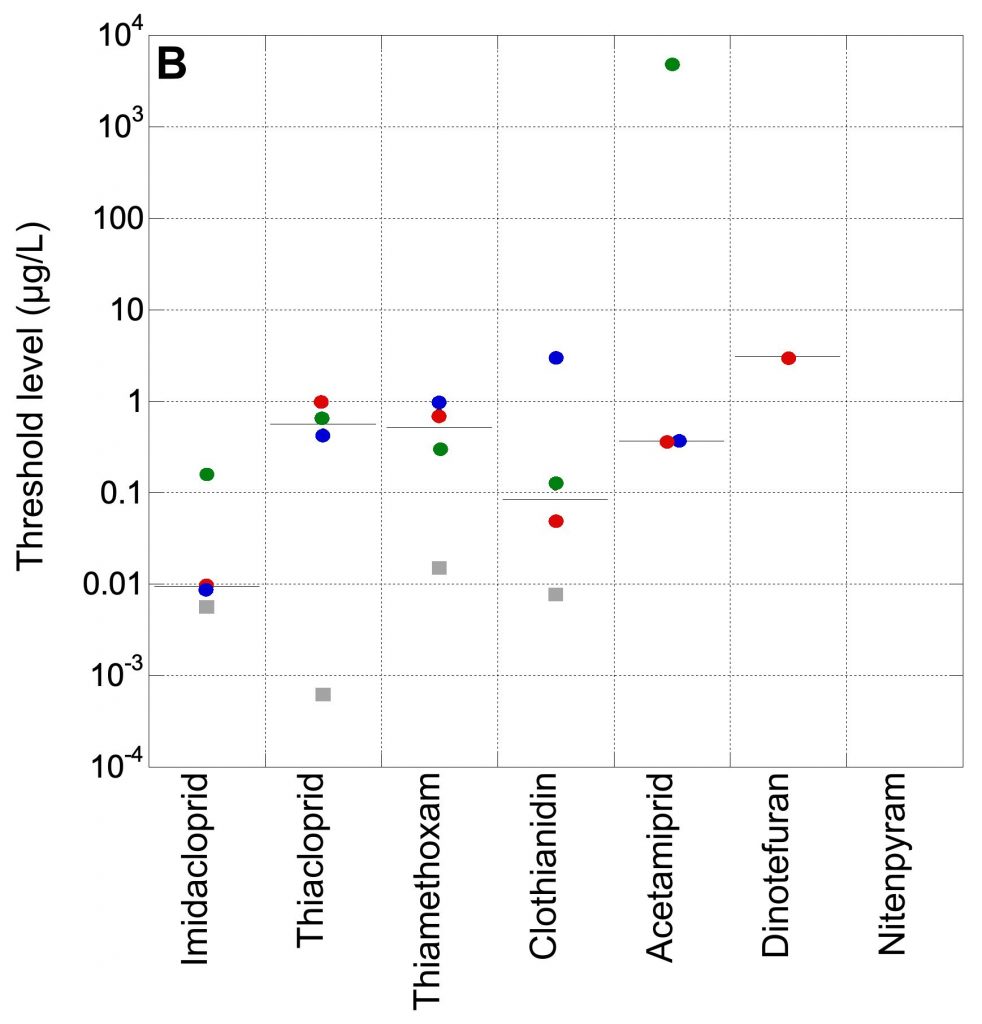In this blog post, Sebastian Stehle presents a meta-analysis on the exposure and risks of the most widely used insecticides in the world, neonicotinoids, for global agricultural surface waters. Although acute risks for aquatic organisms from neonicotinoid exposure appear to be low, risk assessment results also show chronic risks to be of critical concern. Importantly, official regulatory threshold levels (RTLs) determined for pesticide authorization differed widely between countries, indicating large uncertainties and regulatory challenges in defining robust and protective threshold levels for neonicotinoids.
Neonicotinoid exposure of global surface waters
Neonicotinoids, the most widely used insecticides worldwide, are currently registered for use on >140 different crops in over 120 countries. This widespread usage of neonicotinoids has sparked concerns over their effects on non-target ecosystems, with most of the research on neonicotinoid toxicity initially focused on pollinators and, specifically, bees. However, risks for aquatic organisms also received increasing attention in recent years considering particularly that the specific physico-chemical properties (e.g., high water solubility and comparably high environmental persistence) of neonicotinoids foster surface water exposure as a result of agricultural non-point source pollution. However, despite their widespread uses and high ecotoxicity potentials, no systematic analysis of neonicotinoid exposure and risks in global agricultural surface waters exist. In order to fill this gap, we conducted a comprehensive exposure and risk analysis for neonicotinoid surface water concentrations detected in surface waters worldwide. In essence, we employed extensive literature searches to identify neonicotinoid surface water concentrations (n = 3983 concentrations; 7 neonicotinoid compounds) in the scientific literature (n = 173 studies; 1998 – 2022) and analyzed the field concentration dataset using compound-specific acute and chronic regulatory threshold levels (RTLs) defined for pesticide authorization in Canada, the EU and the US.
Neonicotinoids pose high chronic risks
Our results show that despite widespread uses in global agriculture, information on neonicotinoid surface water exposure was available for 40 countries and approximately 7% of global croplands only (Fig. 1). No concentrations were available e.g., for Russia or several other post-Soviet states, India, large parts of Africa or Latin America, although agriculture dominate large areas in these regions. This first result highlights the need for increasing monitoring efforts for neonicotinoids in agricultural surface waters worldwide. However, risk assessment results for available neonicotinoid water-phase concentrations showed acute risks to be low (6.7 % RTLacute exceedances), but chronic risks to be of concern (20.7 % RTLchronic exceedances). Our results thus indicate that one fundamental risk assessment assumption, i.e., pesticide concentrations do not exceed the RTL in the field, is not met for >20 % of available neonicotinoid concentrations. Noteworthy, the often prolonged surface water exposure of neonicotinoids emphasizes the importance of chronic risk evaluations. We also want to stress that ecological risks are likely even higher than indicated here by threshold level exceedance frequencies as (i) ecologically adverse effects can occur already at neonicotinoid concentrations below threshold levels, (ii) prolonged neonicotinoid exposure can trigger effects not covered by regulatory risk assessment, and (iii) synergistic effects of pesticide mixtures containing neonicotinoids have been demonstrated, but are also not included in current RTL setting procedures.

Fig. 1 Distribution of global croplands (grey area) and of (A) acute and (B) chronic regulatory threshold level (RTL) exceedance rates for neonicotinoid water-phase and sediment concentrations (n = 3641) in agricultural surface waters. Information on neonicotinoid surface water exposure was available for 1.13 million km² (7.37 %) of the 15.3 million km² of global croplands only. Figure taken from Stehle et al. (2023).
Regulatory challenges
Pesticide registration authorities define official regulatory threshold levels (RTLs) for market authorization of individual pesticide compounds, that must not be exceeded in the field in order to prevent unacceptable effects on aquatic ecosystems. When comparing the acute and chronic RTLs for freshwater ecosystems defined in Canada, the EU and the US, we found considerable differences of up to a factor of 223 for acute RTLs and 13,889 for chronic RTLs of the individual compounds (Fig. 2 A&B). This finding is astonishing considering that each individual RTL is assumed to be robust and protective, but also not overprotective to avoid unnecessary restrictions of pesticide use. One would thus assume Canadian, EU and US RTLs to show general consistency, given that the risks for identical compounds and similar ecosystems are assessed. Reasons for these large differences in RTls are discrepancies in risk assessment approaches, assessment factors used and test species considered in the individual countries.


Fig. 2 Comparison of (A) acute and (B) chronic regulatory threshold levels (RTL) for water-phase concentrations of the seven neonicotinoids as defined in Canada (green circles), EU (blue circles), and the US (red circles). Lines indicate medians of threshold levels per compound. Figure taken from Stehle et al. (2023).
Overall, we conclude that crucial regulatory challenges exist in defining robust and protective RTLs for neonicotinoids. Large uncertainties and existing shortcomings potentially mask adverse ecological effects in the field. Given the uncertainties of current risk assessment approaches, higher assessment factors for RTLs defined during (re-)authorization of neonicotinoids may be needed to safeguard the ecological safety of neonicotinoid use.
The paper was authored by Sebastian Stehle, Viktoriia Ovcharova, Jakob Wolfram, Sascha Bub, Larissa Zoë Herrmann, Lara Luisa Petschick, and Ralf Schulz and published in Science of the Total Environment.
